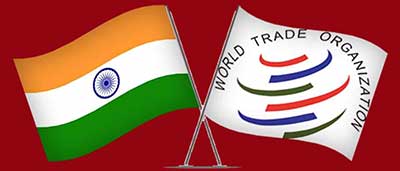Relevance: GS-3: Indian Economy and issues relating to planning, mobilization, of resources, growth, development and employment
Key Phrases: Intellectual Property Rights, TRIPS, process patent, IPR rights, Product Patent, Process Patent, True Monopoly.
Context:
- WTO countries are making progress on the patent waiver for covid vaccines keeping in mind the importance of amendment to the WTO’s IPR (Intellectual Property Rights) norms in the post-pandemic world, the need for vaccines, therapeutics and diagnostics.
TRIPS - Trade-Related Aspects of Intellectual Property Rights
- The WTO Agreement on Trade-Related Aspects of Intellectual Property Rights (TRIPS) is the most comprehensive multilateral agreement on intellectual property (IP).
- It plays a central role in facilitating trade in knowledge and creativity, in resolving trade disputes over IP, and in assuring WTO members the latitude to achieve their domestic policy objectives.
- The Agreement is a legal recognition of the significance of links between IP and trade and the need for a balanced IP system.
- The TRIPS Council is responsible for administering and monitoring the operation of the TRIPS Agreement. In its regular meetings, the TRIPS Council serves as a forum for discussion between members on key issues.
What do WTO’s IPR norms stipulate?
- The Agreement on Trade Related Aspects of Intellectual Property Rights (TRIPS) introduced patent rules into the trading system during the 1986-94 Uruguay round of discussions in the run up to the establishment of the WTO.
- It shifted the focus from ‘process patent’ to ‘product patent’ after including intellectual property rights in the rules of trade.
- IPR primarily covers copyrights and rights related to industrial property, i.e inventions (protected by patents), industrial designs and trade secrets.
- While IPR promotes innovation, it can also lead to higher costs and limited availability of the product.
Product Patent
- Under this regime, the patent is granted to the original inventor
of the product. Here are a few characteristic features of a Product
Patent:
- The grant of a product patent implies that no other person other than the inventor can manufacture the same product using the same process or any other process.
- Product patent provides a ‘True Monopoly’ right to the inventor.
- Product patents are considered to be a higher level of protection compared process patents.
Process Patent
- As the name says, a process patent is granted only to a particular process and not to the end product that is a result of such a process.
- The protection is seen as a limited parent. This is because any other manufacturer or inventor can create the same product using a different process.
- A process patent gives a low range of protection to the inventor. Hence, the chances of competitors reverse engineering the product are high.
- Also, there can be multiple process patents for a single product.
Its Implications:
- The pandemic showed that intellectual property requirements can affect access to medicines.
- In times of a global epidemic or widespread disease outbreak, this can prove fatal.
- Countries, worldwide, especially developing and least developed countries, faced shortages of pandemic-related medicines, especially vaccines as only a few patent holders could manufacture them.
- For example, while there is no scarcity of covid vaccines today, in April 2021, there were only two manufacturers of the vaccine in India with a production capacity of 80-90 million doses of the vaccine per month.

Proposal at the Ministerial meeting:
- In response to a shortage of vaccines and other pandemic-related medicines, India, South Africa and 63 other countries demanded relaxation of IPR provisions covering vaccines, therapeutics and diagnostics to help augment the supply of medicines and kits with expanded manufacturing capacity i.e. beyond the original inventor.
Reason For deadlock:
- Developed countries, originally responsible for pushing IPR as an integral trade agenda, might have been apprehensive that companies other than the patent holders would start manufacturing vaccines, earning huge profits without incurring any R&D costs.
- The counter view is that the profits of a few manufacturers of medicines cannot be allowed to prevail over the global good and a decision to waive IPR rights today can help the poorest deal with any such health crisis that might arise in future.
What could be the way out?
- Dilution of IPR norms could be limited to only crucial medicines and vaccines related to the pandemic and for a temporary period.
- Non-patent holders may be limited to domestic manufacturing.
- Exports, if necessary, could be permitted by sharing R & D costs and profits with the patent holder.
- The agreement signed last week gives developing countries the right to make and export covid vaccines without the consent of the patent holder for a five-year period.
Source: Live-Mint
Mains Question:
Q. Distinguish between Product patent and Process patent. Why does WTO deal on jab patents matter? (250 words).








